This chapter serves as an introduction to ludology, the formal study of games, by establishing foundational frameworks for game analysis. A critical first step in understanding any medium is to grasp its fundamental elements, and these frameworks provide the necessary vocabulary and conceptual tools for a systematic examination of interactive experiences. There are four influential models:
- MDA (Mechanics, Dynamics, Aesthetics) framework (Robin Hunicke, Marc LeBlanc, Robert Zubek)
- Mechanics and Systems (Robert Zubek’s)
- Elemental Tetrad (Jesse Schell)
- Formal, Dramatic, and Dynamic Elements (Tracy Fullerton)
The MDA Framework
The Mechanics, Dynamics, and Aesthetics (MDA) framework stands as one of the most prominent tools in game analysis. First articulated at the Game Developers Conference in 2001 and later formalized in a 2004 paper by Robin Hunicke, Marc LeBlanc, and Robert Zubek, MDA proposes that games can be deconstructed into three distinct, yet causally linked, layers.
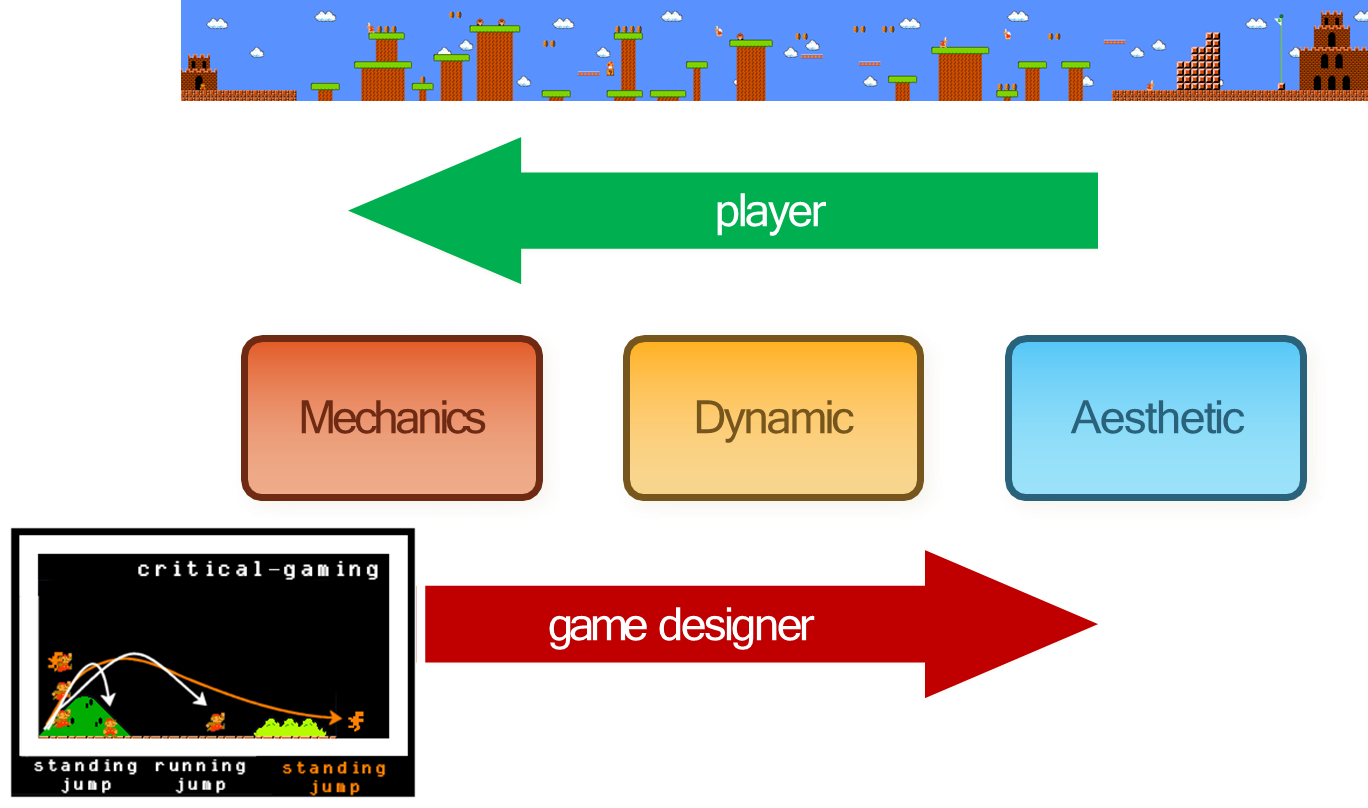
- The Mechanics represent the most fundamental components of a game, encompassing its rules, algorithms, and core data structures. These are the formal, discrete elements established by the designer, such as the actions available to the player, the game’s internal logic, win-loss conditions, and the underlying physics engine.
- From these mechanics, Dynamics emerge. Dynamics are the run-time behaviors that manifest when the player interacts with the mechanics over time. They are not explicitly coded but are the emergent consequence of the game’s systems in action, including player-developed strategies, the pacing of gameplay, and the complex interplay between different mechanical systems.
- The final layer, Aesthetics, describes the desirable emotional and experiential responses evoked within the player. This is the ultimate “feel” of the game, encompassing a spectrum of experiences such as the thrill of Challenge, the immersion of Fantasy, the engagement of Narrative, the camaraderie of Fellowship, the joy of Discovery, the creativity of Expression, or the visceral feedback of Sensation.
This framework maps a direct, causal progression from the game’s formal structure to the player’s internal, subjective state. The core of this model is a linear sequence: Mechanics and Systems give rise to Gameplay, which in turn creates the Player Experience. Here, Mechanics and Systems refer to the raw, objective components of the game, such as its rules, interactive objects, and the set of actions available to the player. Gameplay is defined as the emergent process of a player actively interacting with these established mechanics. Finally, the Player Experience constitutes the player’s cognitive and emotional takeaways—their thoughts, feelings, and psychological responses derived directly from the act of gameplay.
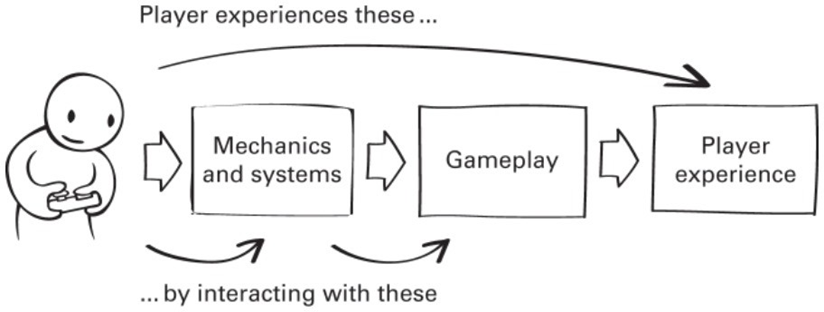
The Opposing Perspectives of Designer and Player
The analytical power of the MDA framework is most evident in its conceptualization of the opposing perspectives from which designers and players approach a game.
The designer operates from a top-down model, beginning with Aesthetics. Their process is initiated by defining a target emotional experience, for example, “I want to evoke a sense of persistent tension and vulnerability.” This aesthetic goal then informs the creation of Dynamics that would predictably generate such feelings, such as gameplay loops involving evasion, concealment, or the management of critically scarce resources. Only after defining these desired emergent behaviors does the designer implement the specific Mechanics—such as a powerful, high-speed antagonist, limited ammunition, or designated hiding locations—that will reliably produce those dynamics.

Conversely, the player experiences the game from a bottom-up perspective. Their initial interaction is purely with the Mechanics, as they learn the rules, controls, and available actions (“I can run, jump, and shoot”). Through sustained play and experimentation, the player begins to perceive and master the system’s Dynamics, recognizing enemy patterns, developing optimal strategies, and understanding the emergent properties of the game’s ruleset (“Timing my jumps allows me to traverse this gap; this enemy follows a predictable patrol route”). It is through the engagement with these dynamics that the player ultimately arrives at the Aesthetic experience. The successful navigation of mechanical challenges leads to a feeling of accomplishment, thus fulfilling the designer’s intended aesthetic goal of “Challenge.”
In essence, designers construct the experience from the intended feeling down to the rules, while players construct the feeling from the rules upward.
MDA Applied to Game Examples
The application of this framework can be observed across a wide range of game genres.
In a classic title such as Super Mario Bros., the core mechanics consist of movement, jumping, stomping on enemies, and collecting power-ups. These simple rules give rise to complex dynamics, including the mastery of momentum for precise platforming, the recognition and exploitation of enemy patterns, and the exploration of the environment to discover hidden blocks and secret paths. The interplay of these dynamics cultivates the game’s signature aesthetics of challenge, discovery, and a palpable sense of growing mastery.
Similarly, in rhythm-based platformers like Geometry Dash or Space is Key, extremely minimalist mechanics—often a single-button input—are employed to generate highly specific dynamics. These dynamics are centered on high-speed survival, trial-and-error pattern recognition, and the rote memorization of level layouts. This design intentionally fosters an intense aesthetic experience characterized by cycles of frustration and the profound satisfaction of eventual success, often inducing a “flow state” where the player’s immersion is total.
The utility of the MDA framework extends beyond digital media, as demonstrated by the classic board game Snakes and Ladders.
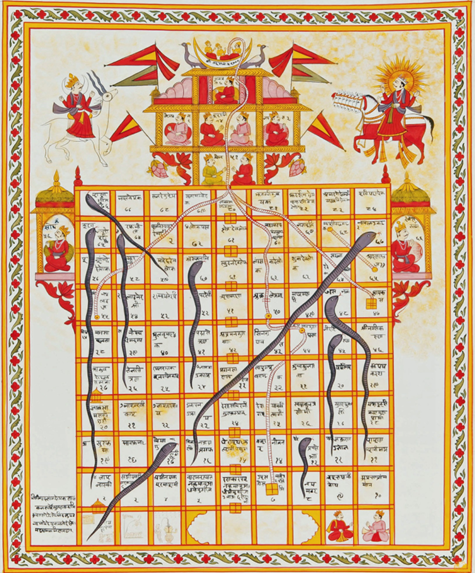
- The primary mechanic of the game is the combination of a random number generator (the dice roll) with the fixed board topology, which includes squares that cause either positive (ladders) or negative (snakes) changes in the player’s position.
- The core dynamic is the resulting volatility of player progression, where a single turn can cause a dramatic and unpredictable shift in a player’s standing relative to their opponents and the final goal.
- The intended aesthetic generated by this system is one of hope, excitement, and the “reversal of fortune.” The thrill of ascending a long ladder and the dismay of sliding down a snake are powerful emotional responses.
The key analytical insight here is that these potent aesthetics are produced within a system that affords the player zero agency or strategic choice, demonstrating that complex emotional outcomes do not necessarily require complex mechanical inputs from the player.
Top-Down and Bottom-Up Design Paradigms
Zubek’s framework serves as an effective lens through which to understand two fundamental and opposing philosophies of game design: top-down and bottom-up.
Top-down design is an experience-driven approach, analogous to the designer’s perspective in the MDA model. The process begins with a clearly defined goal for the Player Experience, such as wanting players to feel like a powerful superhero. Working backward from this experiential objective, the designer conceptualizes the types of Gameplay—such as high-speed traversal and impactful combat—that would evoke this feeling. Subsequently, the specific Mechanics and Systems, like flight abilities, super-strength, and destructible environments, are implemented to facilitate that gameplay.

In contrast, bottom-up design is a mechanic-driven methodology. The process originates not with an experiential goal but with a compelling or novel core Mechanic or system, sparked by a question like, “What if the player could rewind time?” The designer then builds prototypes around this central idea, exploring the various forms of Gameplay that naturally emerge from its implementation. The ultimate Player Experience is therefore not a preconceived target but is discovered and refined through this iterative, exploratory process.
The Expanded Model: Contextual and Sensory Layers
Zubek’s expanded model acknowledges that this core progression from mechanics to experience does not operate in isolation. The player’s interaction with the game’s mechanics is heavily mediated by a host of other contextual elements that shape the final experience. These elements include the game’s Story, which provides narrative framing through setting, plot, and characterization, giving meaning to the player’s actions. Furthermore, the Visual Design, encompassing art assets and the user interface, and the Audio, including music and sound design, provide crucial sensory feedback and establish the game’s tone and atmosphere. Finally, the underlying Technology, such as the quality of the game engine and the affordances of the hardware platform, directly impacts the smoothness and fidelity of the experience.
These components act as essential contextual and sensory layers, transforming the abstract, formal system of mechanics into a rich, cohesive, and immersive world that holistically shapes the player’s perception and emotional engagement.
Elemental Tetrad
Jesse Schell’s Elemental Tetrad provides another key framework for deconstructing games. It posits that a game is a unified experience built from four essential, interdependent components: Aesthetics, Mechanics, Story, and Technology. In Schell’s model, these elements are often visualized at the vertices of a diamond or square, emphasizing that a change in one element will invariably affect the others. A successful game is one where these four components work in harmony, mutually reinforcing one another to create a cohesive whole.
The Four Elements
Schell’s framework is defined by its four core pillars, each representing a fundamental aspect of the game’s construction and experience.

- Aesthetics: It’s crucial to note that Schell’s definition of aesthetics differs significantly from its use in the MDA framework. Here, aesthetics refers strictly to the sensory experience of the game—how it looks, sounds, and feels to the touch. It’s the immediate, surface-level presentation that the player perceives through their senses, including the art style, sound design, music, and user interface.
- Mechanics: Consistent with other frameworks, mechanics are the rules, procedures, and systems that define the game’s interactivity. This element governs how the game functions and what the player can do within the game world. Schell highlights mechanics as the defining characteristic that separates games from non-interactive forms of media like film or literature.
- Story: This element encompasses all narrative aspects of the game, including its premise, setting, characters, and plot. The story provides the context for the player’s actions, giving them meaning and motivation beyond the simple execution of mechanics.
- Technology: The technology is the medium through which the game is delivered and made possible. This can range from digital components like code, rendering pipelines, and console hardware to physical materials such as dice, cards, and game boards. While it is foundational to the game’s existence, technology is often the element least visible to the average player.
Case Study: Space Invaders
The arcade classic Space Invaders serves as an exemplary case study for the Elemental Tetrad, showcasing a near-perfect synergy between its four elements.
The game’s design is a masterclass in how these components can influence each other. The Technology of the time, custom-built arcade hardware, included a processor that was unable to render a large number of alien sprites and process their logic simultaneously without slowing down. This technological limitation unintentionally created one of the game’s most iconic Mechanics: as the player destroys aliens, the remaining ones are rendered faster, causing the entire army to speed up. This creates a powerful feedback loop where player success directly increases the game’s difficulty and tension. Other mechanics, such as the destructible shields and the high-risk, high-reward bonus saucer, added further strategic layers.
This mechanical core was framed by a simple but effective Story. The developer, Taito, originally conceived of the targets as human soldiers but changed them to aliens to avoid the controversial implications of depicting human-on-human violence. This narrative shift provided a fantastical context that made the game’s central action—shooting an advancing army—far more palatable and accessible to a wide audience.
Finally, the game’s Aesthetics were masterfully intertwined with its mechanics to amplify the experience. The simple two-frame animation of the marching aliens, combined with the iconic four-note descending soundtrack, was directly tied to the aliens’ movement. As the game’s pace increased mechanically, so did the tempo of the music and the speed of the animation, creating an unforgettable and anxiety-inducing audio-visual experience. The punishing sound of the player’s ship being destroyed provided strong, clear negative feedback.
In Space Invaders, every element works in concert. A technological limitation became a central mechanic, which was given context by a simple story and brought to life by iconic aesthetics that created a powerful, tension-filled emotional experience.
Formal, Dramatic and Dynamic Elements
Tracy Fullerton’s framework offers a highly structured method for game analysis by categorizing a game’s components into three distinct domains: Formal, Dramatic, and Dynamic Elements.
- Formal Elements represent the game’s foundational structure and rules.
- Dramatic Elements encompass the narrative and emotional layers that provide context and player motivation.
- Dynamic Elements are the emergent properties that arise from the act of playing the game itself.
Together, these categories provide a comprehensive lens for deconstructing any interactive experience.
Formal Elements: The Architecture of Play
Formal Elements are the essential, logical constructs that define a game as a system. If you remove them, the game ceases to exist. At their core is the interplay between the game’s Objective, which is what players are trying to achieve, and its Rules, which are the constraints on their actions. This relationship creates a fundamental equation in game design:
The objective provides a goal, but the rules prevent its effortless attainment, thereby generating the conflict, challenge, and engagement that are the essence of gameplay.
A simple example is golf: the objective is to get the ball in the hole, but the rules governing the use of a club from a distance create the core conflict of the sport.
Other critical formal elements build upon this foundation. Procedures are the specific actions players take to enact the rules, such as taking turns or playing a card. Resources are in-game assets of value, like health, ammunition, or time. The game’s Boundaries define where the game’s reality ends and the ordinary world begins—a concept famously termed the “Magic Circle” by historian Johan Huizinga. The game’s Outcome must be uncertain at the outset to be compelling, and it can range from a definitive win/loss state to more incremental forms of progression.
This “Magic Circle” is not always impermeable. The boundary between play and reality can become fragile, as in-game actions can have profound real-world consequences. Events such as players being professionally criticized for their in-game activities or the community outrage following the disruption of an in-game memorial service demonstrate that the illusion of “it’s just a game” can be broken, proving that powerful emotional and social stakes can cross the boundary of the circle. This highlights the importance of the player’s role, as games fundamentally rely on players voluntarily accepting the rules to enter this space.
The invitation to play is therefore crucial, and is shaped by formal decisions regarding the number of players, their roles (e.g., symmetric or asymmetric), and the designed player interaction patterns, such as one-on-one competition or the one-vs-many structure seen in games like Dead by Daylight.
Dramatic Elements: The Narrative Soul
While formal elements provide the structure, Dramatic Elements provide the soul. They furnish the game with meaning, context, and purpose, answering the crucial question: “Why should the player care?” Even games with minimal formal complexity can be deeply compelling due to their dramatic context.
The escalating tension in Tetris as the blocks fall faster, or the sense of anticipation in a physics puzzler before a chain reaction, are forms of procedural drama.
The Premise establishes the background for player action—be it a ruthless real-estate developer in Monopoly or a hero on a rescue mission in Donkey Kong. Characters serve as the vessel for the player’s journey, functioning either as a blank-slate avatar for player projection or as a predefined role the player inhabits. Finally, the Story is the narrative plot that unfolds through the player’s interaction with the game world, weaving the formal and dramatic elements together.
Dynamic Elements: The Game in Motion
The conflict generated by formal elements creates challenge. The effective management of this challenge is key to creating dramatic tension and can lead to a state of deep immersion known as Flow. Developed by psychologist Mihaly Csikszentmihalyi, Flow theory describes the ideal state where a game’s difficulty perfectly scales with the player’s growing skill. If the challenge is too high for the player’s skill, it leads to anxiety; if it’s too low, it results in boredom. The “Flow Channel” is the optimal path between these two states, where the player feels a sense of mastery and complete absorption.
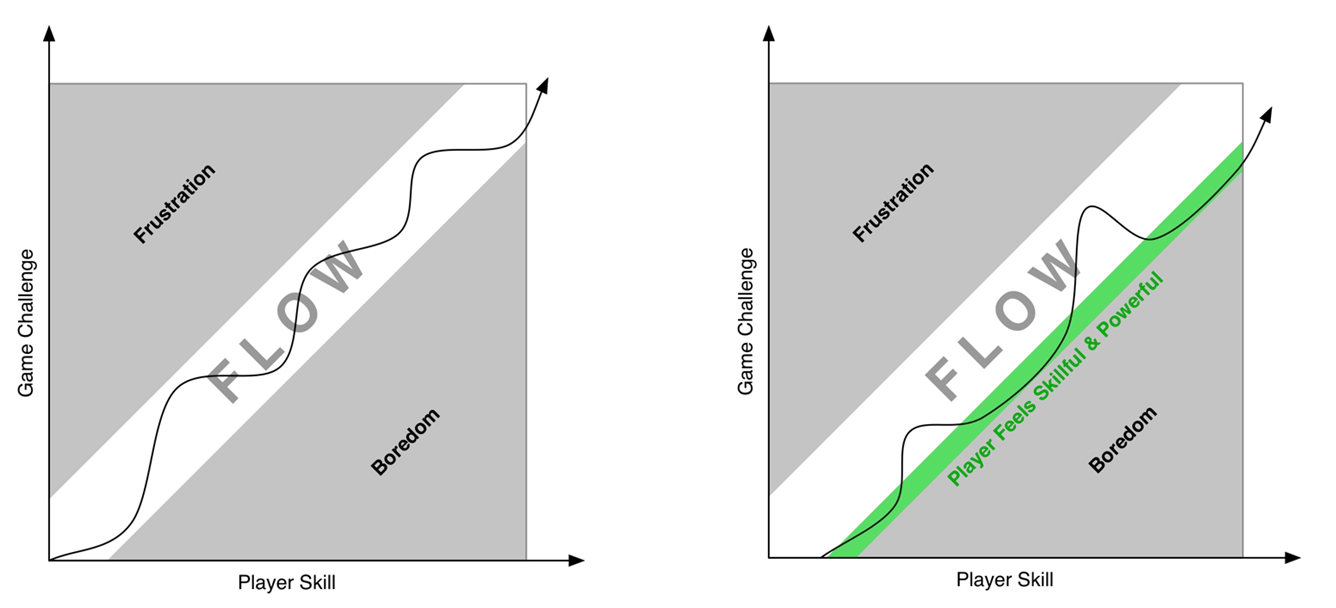
This leads to the final category: Dynamic Elements. These elements are not explicitly designed by the creator but emerge from the interaction between the player and the game’s formal systems. Emergence is the phenomenon where simple rules give rise to complex, unpredictable, and often surprising behaviors. A designer can create the rules of chess, but they cannot script the infinite number of possible games that can emerge from them. This also gives rise to Emergent Narrative, where stories are created not by a writer but by the player’s unique actions and experiences within the game’s systems, as seen in tabletop RPGs like Dungeons & Dragons. Because dynamics are inherently unpredictable, playtesting is the only way to truly understand them. No amount of design theory can perfectly predict how players will interact with a system, making iterative playtesting an absolutely essential process for discovering and refining a game’s true dynamic nature.
Theory of Fun
Raph Koster’s A Theory of Fun for Game Design advances the argument that fun is not an ineffable or mysterious trait of games, but a well-understood cognitive phenomenon anchored in the human brain’s fundamental drive to recognize, learn, and master patterns. Koster affirms that fun itself is a product of the learning process. In essence, the pleasure derived from games is intimately linked to the act of discovering, internalizing, and mastering new patterns, a process that is deeply rewarding on both psychological and neurochemical levels.
Humans are described as remarkable pattern-matching machines, a characteristic underpinned by evolutionary and cognitive imperatives. The brain’s capacity for pattern recognition serves as a vital survival mechanism, facilitating rapid decision-making and problem-solving in complex environments. When humans encounter environments or systems that are excessively chaotic or lack discernible structure—what Koster refers to as “noise”—the resultant cognitive dissonance generates frustration and disengagement. Such experiences are classified as “un-fun” since the absence of patterns prevents meaningful learning from taking place.
Conversely, the moment of pattern discovery yields intrinsic delight. This “aha!” experience, whether unraveling the sequence of an enemy’s attacks or deducing the solution to a puzzle, is the core of what makes an activity enjoyable. Through repeated encounters with patterns, the brain rapidly progresses from initial confusion to comprehension, and finally to automaticity. Once a pattern is fully mastered, it is relegated to a cognitive “chunk”—information that is processed effortlessly and, consequently, no longer stimulates the brain. At this stage, the activity often feels monotonous, and the sense of fun dissipates.
As such, the enjoyment derived from games is optimally maintained by presenting the player with a continual stream of new patterns. The best-designed games act as learning engines, maintaining engagement by balancing the challenge of new patterns against the player’s growing mastery. This dynamic, which Koster correlates with Mihaly Csikszentmihalyi’s concept of “flow,” situates the player in a psychological channel between boredom (from lack of challenge) and frustration (from excessive complexity or randomness).
Koster’s pattern-centric view of fun extends beyond cognitive puzzles to encompass patterns in sensory input. For instance, music that is built on predictable rhythmic or harmonic patterns is generally perceived as pleasurable, whereas compositions that deliberately eschew repetition and structure are often found off-putting or even aversive. The brain’s reward system, notably the release of dopamine, is physiologically tied to the recognition and mastery of patterns—explaining why games, at their most fundamental level, function as sophisticated dopamine delivery systems.
Example
The Super Mario series exemplifies Koster’s theory in practice. Each level introduces players to new configurations and sequences, such as the timing of obstacles or enemy movements. Furthermore, the game continuously expands the player’s repertoire of movement patterns and challenges them to deploy these newly acquired skills in novel situations, thereby sustaining engagement and maximizing fun. Here, “teaching through play” emerges as a central tenet: robust level design operates as a visual and experiential language that guides, tests, and ultimately rewards players for their pattern mastery.
Theory of Unfun
While Raph Koster’s theory explains the cognitive mechanisms that generate fun, Scott Rogers’ Level Up! The Guide to Great Video Game Design offers a complementary and practical framework focused on the elimination of “unfun.” Rogers proposes that fun is what remains after all sources of negative player experience have been systematically removed. This subtractive design philosophy, which he terms the Theory of Un-Fun, serves as a critical guideline for developers who may lose objectivity during the production cycle. The core principle is deceptively simple:
If you find something in the game that is not fun (or un-fun) remove it. After you have removed all the un-fun, all that should be left is the fun.
Through this iterative process of removal, the game is refined until only engaging and enjoyable components persist. This method directly addresses what Koster identifies as “noise”—the chaotic or overly simplistic patterns that lead to player disengagement—by treating its removal as a primary design goal.
To prevent a game’s conceptual novelty from becoming overwhelming “noise,” Rogers introduces a heuristic called the Weirdness Triangle.
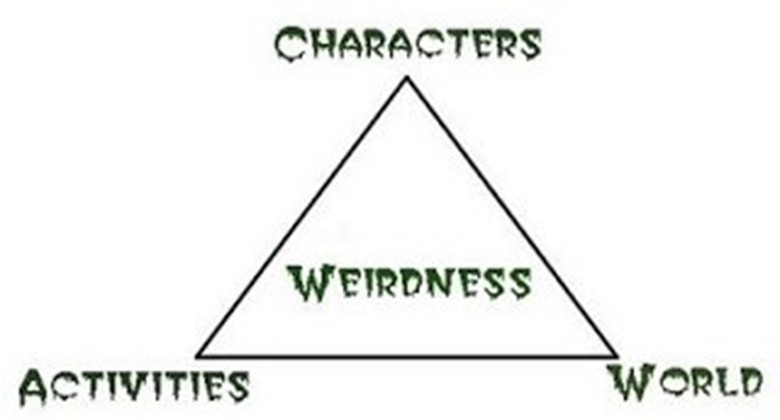
This framework posits that a game’s world is built upon three foundational pillars: its Characters, the Activities players undertake, and the World in which the game is set. The rule suggests that a designer can innovate or make one of these pillars “weird” and unconventional while the other two should remain familiar to ground the player’s experience. For instance, a game can feature strange Characters, like anthropomorphic animals, and remain accessible if the World (e.g., a contemporary city) and Activities (e.g., driving and racing) are conventional. Similarly, a bizarre fantasy World can be successfully navigated by players if the Characters are recognizable archetypes (e.g., heroes, villains) and the Activities are familiar (e.g., sword combat, questing). This tool helps designers balance novelty with comprehensibility, ensuring that the cognitive load of learning new patterns does not become a source of frustration.
